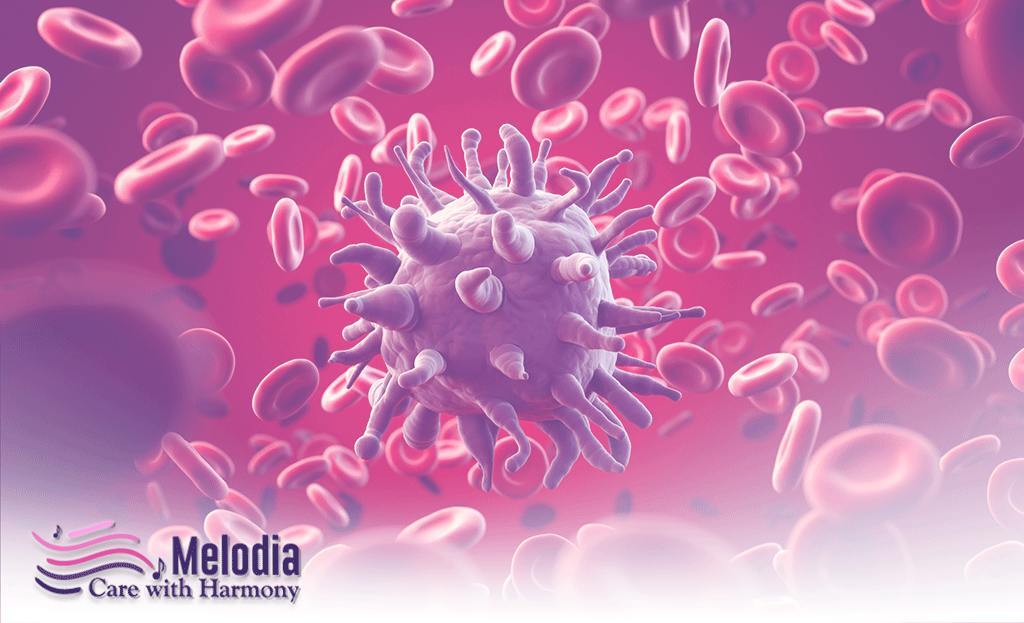Sepsis develops quickly, unlike other severe or chronic diseases that often lead to hospice. Infections that cause sepsis can rapidly spread and worsen if not properly managed. Hospice admissions staff should be notified of sepsis immediately since Melodia Care Hospice can aid.
What’s sepsis (septicemia)?

When the immune system fails to fight an infection, it damages tissues and organs causing sepsis, a life-threatening illness. Bacteria, fungi, viruses, and parasites can cause sepsis. Primary sepsis infections typically affect the bloodstream, lungs, brain, urinary tract, skin, and abdominal organs.
When the immune system overreacts and releases chemicals into the bloodstream to fight infection, sepsis can be fatal. Inflammation caused by these substances can produce many symptoms and serious problems.
Any infection bacterial, viral, or fungal can cause sepsis. Pneumonia, urinary tract, skin, and stomach infections are common causes of sepsis. Sepsis is likely in elderly adults, babies, and chronically unwell persons with compromised immune systems.
How hospice helps patients with sepsis?

Hospice care at Home can provide comfort and support to sepsis patients and their families.
Sepsis hospice care emphasizes comfort and symptom management. They address pain, fever, and other symptoms. Hospice professionals effectively manage patients’ symptoms and provide comfort. Hospice care helps patients and families cope with stress and uncertainty.
Many sepsis victims feel helpless and powerless. Hospice care helps people maintain dignity and independence. This involves bathing, clothing, and encouraging patients to do what makes them happy.
Sepsis hospice care involves educating and supporting families. Family members may feel overwhelmed or need clarification about how to keep a loved person with sepsis. Hospice specialists can assist families in comprehending the disease, anticipating problems, managing symptoms, and providing emotional support. They can help families with end-of-life planning.
What are the three stages of sepsis?

Sepsis has three stages, and hospice referrals should be made early.
1. Sepsis.
Sepsis initiates a systemic immunological response. Antibiotics, fluids, and supportive care started within hours of diagnosis help most persons with mild sepsis recover.
2. Severe sepsis.
Severe sepsis affects brain, heart, and kidney blood flow. It can also create blood clots in internal organs, arms, fingers, legs, and toes, resulting in varied degrees of organ failure and gangrene (tissue death). The majority of sepsis-related deaths occur in hospitalized patients (34%).
Symptoms of severe sepsis include:
- Difficulty breathing and shock.
- Kidney, liver, and metabolic damage (reduced urine output)
- Mental state changes/delirium
- Heavy bleeding
- Blood lactate increases.
3. Septic shock.
Severe sepsis lowers blood pressure, causing septic shock.
How can hospice help with sepsis?

Hospice care is available to patients whose doctors estimate a six-month life expectancy.
Sepsis infections are common in hospitalized or ICU patients. Multiple-diseased elderly and feeble people can be handled and sent to outpatient treatment. Diseases weaken the body, causing a steady deterioration.
Sepsis patients who have survived hospitalization and are declining should be considered for hospice nurse goals-of-care talks.
Will hospice care for sepsis?

Sepsis and severe illness. Since sepsis can rapidly progress, the hospice team coordinator should be contacted immediately. Hospice care may be the most excellent option to handle long-term symptoms, suffering, and family support if sepsis does not kill the patient.
Sepsis vs Septic shock?

Bacteria, viruses, and fungi cause sepsis.
In septic shock, a patient’s blood pressure drops severely as a result of the body’s response to an infection. Normalizing blood pressure with drugs and fluids can be challenging.
How does septic shock happen?

Sepsis occurs when a patient’s immune system is weakened by underlying health issues or chronic diseases. Approximately 73% of sepsis patients are already hospitalized, and 26% develop sepsis during their hospital stay.
Cancer, dementia, stroke, chronic lung, heart, liver, or kidney disease predispose vulnerable persons to sepsis.
Poor nutrition, worsening functional or cognitive conditions, or unmanaged symptoms might make sepsis harder to fight.
Patients with sepsis can progress to septic shock. When sepsis worsens, blood pressure drops dramatically, making therapy difficult.
Doctors use temperature, heart rate, breathing rate, blood/platelet counts, biomarker analysis, and other cultures/tests to diagnose sepsis and find the infection source.
Who’s at risk for sepsis?

Patients who are:
- Very youthful or old.
- Chronic sickness or drug-resistant bacterium.
- HIV, cancer, transplant medications, diabetes, or severe trauma decrease immune systems.
- Have advanced cancer, heart failure, advanced lung disease (shortness of breath at rest or with minimal exertion, with or without oxygen), or dementia with any difficulty with activities of daily living (eating, bathing, dressing, toileting, personal hygiene, etc.).
- Use intravenous catheters, breathing tubes, or heart-assist devices.
When does a patient with sepsis eligible for hospice care?

Hospice care is available to sepsis patients whose doctors estimate a six-month life expectancy.
However, many sepsis infections occur in hospitalized, critically ill, ICU, or post-op patients. However, old or disabled individuals may be handled and discharged to outpatient treatment, only to continue to worsen this insidious disease. Sepsis survivors who are declining should be examined for goals-of-care dialogues. These discussions determine end-of-life care preferences. Hospice care is the recommended option for eligible patients who prefer to receive care at home.
When severe progressive sepsis or unstable patients are found late in the disease, hospice admissions staff should be called immediately. Hospice care may be the most excellent option to handle long-term symptoms, suffering, and family support if sepsis does not kill the patient.
Does hospice help sepsis patients?

According to recent research, 40% of sepsis patients who died in the hospital were hospice-eligible before admission. Sepsis patients often qualify for compassionate hospice care, despite the notion that they must stay in the hospital:
- Hospice reduces discomfort and helps patients enjoy life while letting them make as many decisions as possible. When symptoms worsen, dedicated staff members can provide round-the-clock care until symptoms are under control.
- Hospice provides emotional and spiritual support to patients.
- Melodia Care Hospice treats patients in their homes, long-term care centers, and assisted living communities. If symptoms become too difficult to manage at home, inpatient facilities can provide 24-hour care until the patient can return home.
How should you approach hospice discussions?

When unprepared, discussing hospice care might be intimidating. Goals-of-care discussions should include the following:
- Clarifying patient health and illness progression
- Knowing your options
- determining patient and family goals
- Speaking and listening
- Engaging in proactive conversation
Additional suggestions for families and patients facing severe sickness, hospitalization, or several operations that put them at risk of sepsis:
Express your wishes to Discuss, write, and share. Before a crisis, sepsis patients should write out their end-of-life wishes. If you have a life-limiting diagnosis of sepsis, choose your treatments. With a living will or durable power of attorney for healthcare decisions, your family, healthcare proxy, and healthcare team can make end-of-life care decisions without shame or conflict.
If you or a loved one is facing sepsis or considering hospice care, contact Melodia Care Hospice today for compassionate support and assistance.








